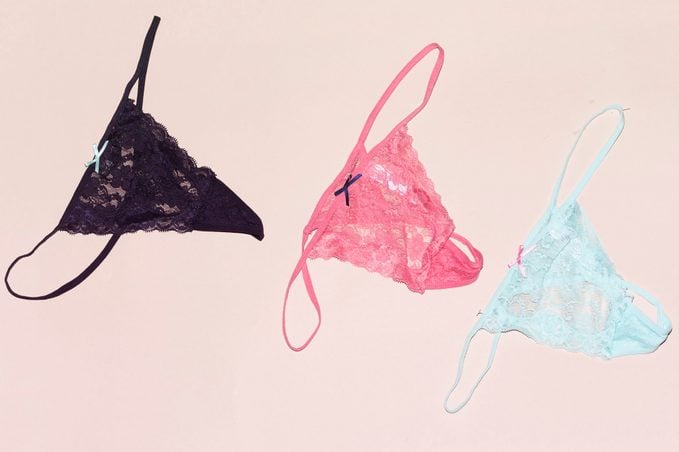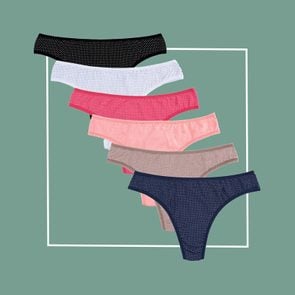Are Thongs Bad For Your Health?
Updated: Apr. 13, 2021
Go ahead and don that thong—but use these tips on how to wear a thong to lower your risk of infections, minimize irritation, and stay fresh and healthy.
Our editors and experts handpick every product we feature. We may earn a commission from your purchases.
The lowdown on the thong
The short answer about your undershorts: When it comes to your health, your style of underwear—thong, brief, bikini, or other—is not as important as the cleanliness, material, and fit, says Rochelle Torgerson, MD, a dermatologist with the Mayo Clinic in Rochester, Minnesota.
(This is the healthiest women’s underwear you can buy.)
“It’s really a matter of preference. If you are comfortable in a thong, it is fine,” Dr. Torgerson says. “Nothing is inherently wrong with this style. Irritation is the limiting factor, and this is very person-dependent.” Just make sure you’re not making these common underwear mistakes.
However, if you’re a thong devotee and want to know the ins and outs of this type of underwear, we’ve got you covered.
The popularity of thongs
For being an “unmentionable,” plenty of people like to talk about thongs. There’s even the infamous “Thong Song” by Sisqó that topped the music charts in the early 2000s. It’s not just talk either.
In a study of about 1,000 women published in 2019 in The Journal of Obstetrics and Gynaecology Research, one in five reported wearing thong undies at least 50 percent of the time
Men wear thongs too. Sherry A. Ross, MD, an ob-gyn in Santa Monica, California, and author of She-ology: The Definitive Guide to Women’s Intimate Health, understands: “Many [men] will say they love the feeling of being ‘secured in the front and free in the back,’ while others will tell you that guys don’t like panty lines either,” she says.
“Wearing undergarments is definitely a personal choice regardless of your gender,” says Dr.. Ross.
In a 2017 survey conducted by Underwear News Briefs, a blog about men’s underwear, just over 40 percent of respondents said they wear a thong one to four times a month.
(Here’s why we wear underwear.)

Types of thong underwear
There are way more types of thong undies than just the standard version, and people who don’t mind a perma-wedgie have lots of options.
Traditional thong: A style of underwear that provides coverage in the front but leaves the backside exposed. A thin strip of material goes under the crotch and between the butt cheeks before attaching to the waistband in the back.
G-strings: Undies with a triangle of fabric at the front and a much thinner strip of material—often just a string—holding it together. (The “G” stands for groin.) They are generally considered more lingerie than practical underwear.
Frongs: “Front thongs” are like regular thongs but the strip of material is thin from front to back, also going between the labia.
Fancy thongs: Lingerie-style thongs come in a wide variety of styles meant to be titillating, including edible, crotchless, bondage, and those using a different material for the strip of fabric, like a string of pearls.
Shaping thongs: Plenty of shapewear brands offer thong-style undies that also offer compression in the front to flatten the tummy. They may also offer styles with an additional strap underneath each cheek to lift and shape the butt. (Could your clothing choices be killing you?)
Jockstraps: An undergarment worn by men during athletics to provide support and protection to the genitals. From an aesthetic view, they look very similar to regular thongs.
Why people wear thongs
People who don’t wear thongs often want to know what the appeal is. There are several reasons that a man or a woman may choose to wear one. Thongs are the tried-and-true way to make sure you have no visible panty lines—indents that cut across the butt when wearing tight clothing—without going commando.
Some people find them more comfortable than regular underwear. Some enjoy the feeling of wearing “sexy” or “taboo” undies. And others just like the way they look.
(Find out if you should wear underwear to bed.)
What to consider before wearing a thong
There are some downsides to having your underwear lodged up your bum. Top of the list for women is managing their periods, Dr. Ross says. It can be difficult and uncomfortable—but not impossible—to fit maxi pads into thongs, and women who deal with bloating may find this style unsupportive.
(Here’s what happened when one woman tried period underwear.)
Perhaps the bigger issue, however, is comfort. “Thongs tend to slide back and forth while you move, leading to friction and chafing in delicate areas,” says David E. Bank, MD, a dermatologist and founder of The Center For Dermatology in Westchester, New York.
People who hate wearing thongs generally avoid them because they just don’t like how they feel.
Fabric
Thong undies come in every fabric imaginable including satin, lace, spandex, performance blends, rayon, polyester, and cotton. Many people have specific preferences in their underwear fabric, and whatever you choose is fine as long as you’re comfy.
When it comes to genital health, the only fabric you need to worry about is the lining of the gusset, or crotch, Dr. Ross says. She recommends wearing a thong with a cotton—or a cotton-blend—gusset, even if the rest of the undies are made of something else, as it’s more breathable.
The exception is underwear designed specifically for athletics. “Technical undies are a great idea when working out because most of them are stretchy but supportive during movement,” Dr. Bank says.
“They also wick sweat far more efficiently than cotton to help keep you drier.” Some even come with antimicrobial treatments on the fabric to help fight odor and infection.
Size
Be sure to look at the size chart before purchasing. Too-small undies can pinch in delicate places and give you muffin-top lines, while thongs that are too large can slide around, causing uncomfortable genital chafing and pain, Dr. Ross says.
Fit
The thong you decide to go with should feel form-fitting and comfortable. Pay special attention to the waistband: Thongs come in low-, mid-, and high-rise options and different widths. Try several different kinds until you find the ones best suited for your anatomy or style needs.
For instance, some women with recent C-sections (cesarean sections) avoid low-rise underwear because it rubs against their scar, while women with shorter torsos may prefer them. High-rise thongs may look smoother under a bodycon dress, and a thicker waistband can help smooth out bumps.
So is it safe to wear a thong?
Comfort and fashion aside, many people worry about thong underwear increasing their risk of infection or injury. (Any style of underwear can increase your risk of bumps when it gets warm and wet; here’s how to get rid of acne in places other than your face.)
“Due to [thongs’] anatomically unfriendly design, it may be easier for harmful bacteria of the colon to find their way into the vagina and bladder, increasing the risk of infection,” Dr. Ross says. This becomes an even bigger risk if you’re wearing a thong that is dirty, hasn’t been properly laundered, or doesn’t fit well.
That said, the risk is likely small. The 2019 The Journal of Obstetrics and Gynaecology Research study found no increase in urinary tract infections or bacterial vaginosis in women who wore thongs regularly versus those who didn’t. Women whose thongs didn’t have cotton crotches, however, had more yeast infections.
For men, there is sometimes the question of injury due to strangulation or entanglement of the penis or testicles in thongs, particularly styles that come with lots of thin straps. This risk is easily managed by making sure the thong fits properly and is worn correctly, Dr. Ross says.
For both men and women, there’s a small risk of getting a friction burn or chafed, irritated skin from wearing certain types of thongs, Dr. Banks says. If this happens to you, try a different style or fabric.
We’re not trying to be cheeky, but the bottom line is that thong underwear is safe, so if you find it fun and comfortable, feel free to wear it as often as you like.

Washing your thong
Experts generally recommend changing your underwear daily to prevent the buildup of dirt, sweat, and germs. However, there may be times you should change it even more frequently—say, after a sweaty workout or on heavy period days, Dr. Ross says.
Launder the thong in hot water with detergent after each use. Some fancier thongs may require hand-washing, so read the label first. (Follow the rules for the only way you should be cleaning your underwear.)
When to replace your thong
A good pair of undies is like a good pair of jeans: It may take some time, but eventually, they’ll wear in and fit exactly the way you like them. You can keep your underwear as long as they are clean and comfortable, but if they have visible stains, no longer fit properly, have holes, or are unsupportive, it’s probably time to invest in some new ones, Dr. Ross says.
The thong portion of thong undies can become stretched out over time, leading the underwear to move around or get twisted during wear.
Replace any thongs where the strip of fabric doesn’t nestle comfortably between your butt cheeks.
Next, learn more about what happens if you don’t change your underwear.





















